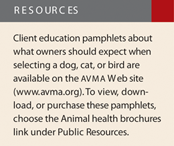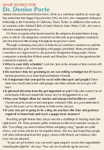Assist owners in selecting the best pets for their lifestyles
Although it is obvious to veterinarians that a Border collie and a 96-year-old woman likely make a poor pet-owner match, it may not be obvious to a potential owner who has never been around Border collies. Indeed, one reason healthy animals wind up in shelters, says Gail Golab, PhD, DVM, American Veterinary Medical Association (AVMA) interim director for animal welfare, is because people "acquire a pet with an expectation the pet doesn't fulfill."
Although it is obvious to veterinarians that a Border collie and a 96-year-old woman likely make a poor pet-owner match, it may not be obvious to a potential owner who has never been around Border collies. Indeed, one reason healthy animals wind up in shelters, says Gail Golab, PhD, DVM, American Veterinary Medical Association (AVMA) interim director for animal welfare, is because people "acquire a pet with an expectation the pet doesn't fulfill."
All too often, says John Ciribassi, DVM, DACVB, people do not carefully consider their choice of pets. They do not think about how much attention, exercise, and grooming a dog will need and whether they are willing to devote that much time to the dog's care. "Adding a dog is no different from adding a baby to the household," he says. "They're talking about adding a life to their home."
HELPING YOUR CLIENTS
If a client tells you he or she is thinking about getting a new pet, ask lots of questions to get more background information, says Dr. Ciribassi. "For example, I strongly advise clients against getting a dog when there are children under 6 in the home,"he explains. "Managing young children and a dog at the same time is difficult, especially because of the potential fearful response to active children and their friends in the home. Cats can be ideal in such situations because most cats will learn to avoid young, active children, while dogs may become aggressive."

A preadoption checklist
In addition, make sure owners assess whether they have enough room and money to provide for another pet. And owners should consider whether their old pet will get along with a new one (see "A preadoption checklist" for a list of questions that Dr. Ciribassi asks potential owners).

Resources
Your time in the examination room is limited, so consider training staff members as preadoption counselors (see "What works for Dr. Denise Porte"). Then clients can set up appointments with these counselors to further discuss pet selection.

Advice from the Veterinary Medicine Practitioner Advisory Board
And don't wait for clients to ask you about adopting pets; be proactive. Advertise your preadoption counseling services in the clinic lobby or examination room, and when appropriate, mention that you are available to discuss it.

What Works for Dr. Denise Porte
HELPING NONCLIENTS
Of course, not all potential owners are clients. So how do you reach these potential owners before they make a decision on which pet to adopt?
Dr. Golab suggests setting up an information booth at local festivals or anywhere else people gather. Ask these potential owners the same preadoption questions you ask your clients plus a few more ("Have you had a pet before?") since you do not have any background information. Although these booths are volunteer situations, she says that once the word gets out that you offer this service, people are likely to make appointments for further discussion and to recommend you to friends who are thinking about adopting a pet.
Dr. Golab also suggests volunteering at local shelters. "Shelters have lots of charity events. It makes sense to have a veterinarian there, helping people decide what pets or breeds would be best for them." In addition, she'd like veterinarians to train shelter workers in preadoption counseling so that good matches are made when veterinarians are not on site.
CONCLUSION
Adopting a pet should be a lifelong commitment. But often people adopt without realizing how big of a commitment they are making or they select a pet based on the wrong criteria—then they relinquish the pet because it doesn't fit their lifestyles. By taking the time to discuss pet selection with potential owners and helping them make a good pet match, you'll reduce the risk of relinquishment.